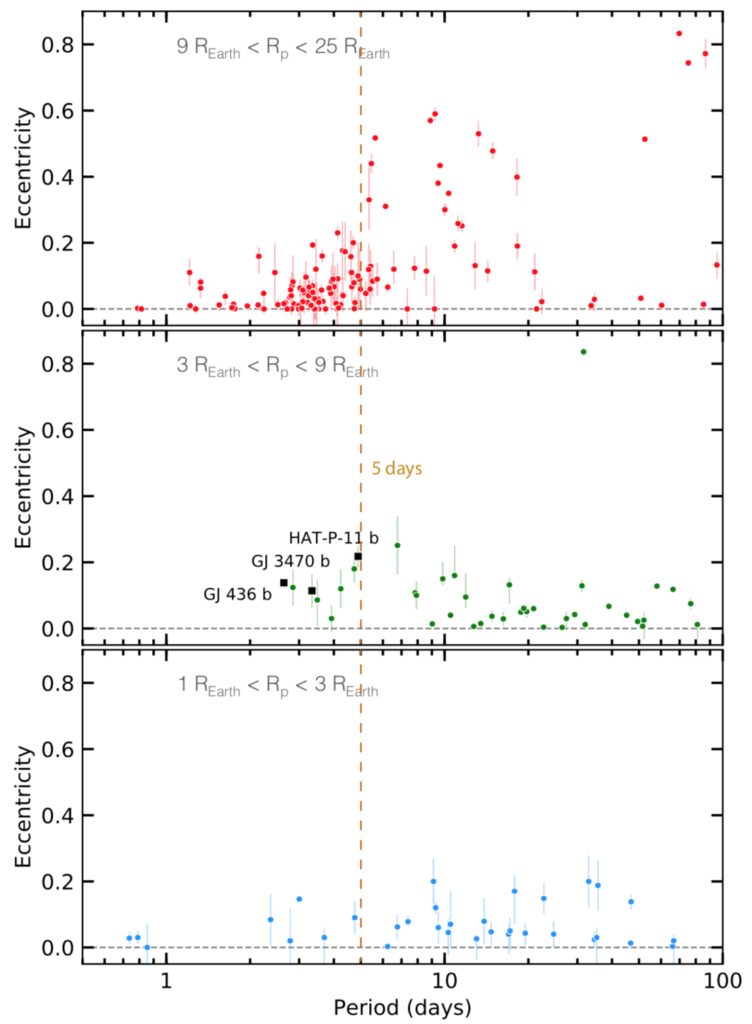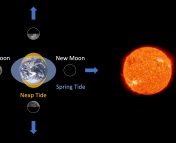Title: Why do warm Neptunes present nonzero eccentricity?
Authors: A. C. M. Correia, V. Bourrier and J. -B. Delisle
First Author’s Institution: Department of Physics, University of Coimbra, Portugal
Status: Accepted to A&A, open access on arXiv
What makes a planet a planet? Do we consider their relative size, whether they trace a path backwards in the sky when viewed from Earth, whether there’s anything around the immediate vicinity of their orbit, or whether there’s so many such objects that after encountering about eight or so we decide to stop counting? With wave after wave of successful exoplanet detections by space telescopes such as Kepler and TESS, and even ground-based telescopes such as WASP and TRAPPIST, our understanding of what a planet can be has grown tremendously.
The Tides That Bind
In today’s post we will be looking at a peculiar class of exoplanets called Hot Neptunes (a.k.a warm Neptunes). These are gaseous, Neptune-like exoplanets that orbit extremely close to their host star such that a year on the planet is on the order of several days to a week.
This close to the host star, the immense gravitational forces cause the planet to bulge. Yet since the planet is also rotating, this means that the bulges are angled slightly offset from the host star; the resulting torque can alter the planet’s orbit. To get an intuitive feel for how such tidal forces can modify orbits, we need only look our own solar system. Due to tidal interactions, the Moon is ever so slowly moving away from the Earth (about 2-3 cm/year). Left to continue, the Earth and the Moon will eventually be tidally locked to each other, just like Pluto and Charon.
Death, Taxes and Tidal Equilibrium
Tidal interactions are of key interest when it comes to exoplanets. As for an exoplanet orbiting extremely close to its host star, there’s two outcomes. The planet either enters a death spiral, or an equilibrium state defined by three factors: coplanarity (the equatorial plane is aligned with the orbital plane), a circularisation of the orbit (reduced eccentricity over time), and corotation (tidal locking). An orbit’s eccentricity, denoted e, is a nonnegative scalar quantity, such that 0 is perfectly circular, 0 < e < 1 is elliptical, 1 is parabolic and e > 1 is hyperbolic.
The time taken for a planet’s orbit to circularise is dependent on several factors, including its mass, the mass of its host star, its rheology (how it deforms) and its initial eccentricity. Calculations by the authors show that all Neptune-mass planets with orbital periods less than 5 days should circularise in less than 5 Gyr. Surprisingly, as can be seen in Figure 1, almost all observed warm Neptunes have a higher than expected eccentricity (they should have circularised by now!)

When examining Figure 1, two things stand out. One is the “Neptunian desert”; the lack of warm Neptunes with orbital periods less than two to three days. The second is that the orbits of warm Neptunes have abnormally high eccentricities (above 0.1) compared with Jupiter-sized and Earth-sized exoplanets with the same orbital period (around 3-5 days) where many have eccentricities closer to 0.
Why are they so eccentric?
One thing to consider is whether warm Neptunes are initially formed with highly eccentric orbits, in which case the time taken to circularise can be many times greater than the age of the system. A warm Neptune with a highly eccentric orbit will remain highly eccentric (e around 0.6 to 0.8) for a long time (see Figure 2). We should therefore see warm Neptunes with high eccentricities, but almost all observed warm Neptunes have eccentricities no greater than 0.25 (Figure 1).

Tides aren’t just gravitational…
So far we’ve only discussed bodily tides (tides that cause an object/body to deform), but warm Neptunes are also subject to thermal atmospheric tides. Warm Neptunes experience strong temperature gradients, which in turn affect the atmospheric pressure throughout the planet as hotter air moves towards cooler regions. This overall displacement may help to counterbalance the reduction in eccentricity.
…nor are they strictly between two bodies
If a warm Neptune is incapable of preventing the full circularisation of its orbit by itself, it is possible that its orbit is being perturbed by a large, undetected companion somewhere in its outer system (similar to how a theoretical Planet Nine is believed to influence the orbits of objects in the Kuiper belt). The authors note caution with this approach, for not every anomalous orbit needs a hidden companion in order to be understood (as in the case of Mercury where an overhaul of gravity sufficed). However, even if an outer companion were to interact with a warm Neptune, the combined effects are insufficient to explain the observed distribution of warm Neptunes as in Figure 1.
Some measurements required
While this paper describes several theoretical mechanisms that can prevent a warm Neptune’s orbit from fully circularising, the authors note that no mechanism is sufficient on its own to explain the observed discrepancies. One major limitation is the theoretical nature of the modelling. The key to overcoming this lies in the future search for exoplanets and high-precision measurements. Each new discovery helps fill in the gaps in our understanding, until one day it will be possible to model an exoplanet right down to its core and finally shed light on why warm Neptunes defy the tides.




